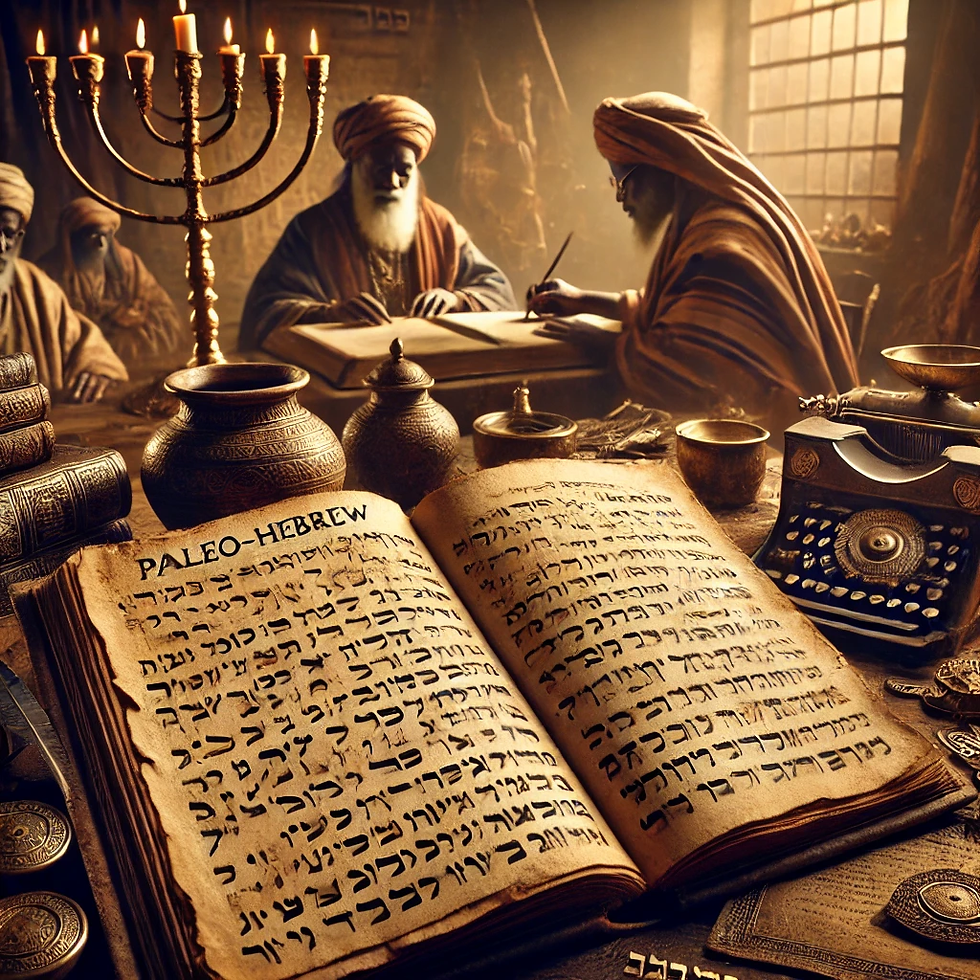Paleo-Hebrew: Why Its True Pronunciation Cannot Be Known
- TayU Yaho
- Oct 18, 2024
- 3 min read
Paleo-Hebrew, a script and language used by the ancient Israelites, belongs to the broader Canaanite family and shares many similarities with Phoenician script. One of the most important characteristics of Paleo-Hebrew is that it was a consonantal language, meaning that it lacked written vowels. This absence of written vowels necessitated an oral transmission system where individuals were taught how to speak and understand the language directly from those who had already mastered it. As a result, pronunciation was preserved through generations by word of mouth. However, once Paleo-Hebrew ceased to be spoken as a living language, the original phonetic patterns were lost to time. Today, the language is considered "dead," meaning that no one in modern times can definitively claim to know how it was pronounced. This fact directly challenges the assertions of those who claim to have rediscovered or know the exact phonetic structure of Paleo-Hebrew. Such claims cannot be substantiated because no reliable sources or native speakers exist to verify them.
The Role of the Masoretes and the Introduction of Vowel Points
The Masoretes, a group of Jewish scholars from the 7th to 10th centuries CE, introduced the system of niqqud, or vowel points, to Hebrew texts. Their goal was to standardize the pronunciation of the language for readers. However, it is important to stress that the Masoretes did not possess direct knowledge of how Paleo-Hebrew was originally spoken either. Their system was not an attempt to restore an ancient, forgotten vocalization but rather to preserve the pronunciation of Hebrew as it had evolved in their own time.
The vowel points they added to the Hebrew script were based on oral traditions that had already undergone significant changes over the centuries. Therefore, their vowel system is, at best, a reflection of how Hebrew was pronounced during the medieval period—not an authentic restoration of Paleo-Hebrew. The Masoretes faced the same problem as anyone else studying a language without written vowels: they were engaging in educated guesswork and transliteration. Consequently, their vowel points are an interpretation rather than an exact record of ancient pronunciation.
The Evolution into Modern Hebrew
Modern Hebrew, which is spoken today, represents another significant shift from Paleo-Hebrew. This version of the language was revived primarily through the efforts of Eliezer Ben-Yehuda, a 19th-century linguist of Ashkenazi Jewish descent. However, it is crucial to note that Modern Hebrew has little to do with the true ancient Hebrew, let alone Paleo-Hebrew. Ben-Yehuda's revival of Hebrew did not involve a direct restoration of the language as spoken in ancient times but was rather a reconstruction influenced by European languages such as Yiddish, German, Russian, Polish, and English. As a result, Modern Hebrew incorporated many loanwords from these languages and was shaped by modern European linguistic structures, making it a fundamentally different language from the original.
This modern construct does not reflect the true phonetics or grammatical structure of the Hebrew spoken by the ancient Israelites. Instead, it is a linguistic hybrid, influenced heavily by the modern European context in which Ben-Yehuda lived. The idea that Modern Hebrew is a true continuation of Biblical Hebrew is misleading, as it has been shaped by centuries of linguistic changes and external influences.
The Greek Sources and Their Limitations
Some scholars rely on Greek transcriptions of Hebrew words, particularly from the Septuagint (the Greek translation of the Hebrew Bible), to provide clues about ancient pronunciations. However, even these transcriptions are problematic. The Greek alphabet had different phonetic limitations, and the way Hebrew words were rendered in Greek often reflected how Greek speakers heard those words rather than how they were originally spoken in Hebrew. This creates further uncertainty, as the transcriptions do not provide definitive evidence of how ancient Hebrew was pronounced.
Conclusion: The Truth About Paleo-Hebrew Pronunciation
Given the loss of oral tradition, the lack of vowel markers in the original script, and the significant passage of time, no one today can claim to know exactly how Paleo-Hebrew was pronounced. The Masoretes, despite their best efforts, did not have access to this knowledge, and their vowel point system represents an interpretation from the medieval period rather than a faithful reproduction of ancient phonetics. Modern Hebrew, on the other hand, is a 20th-century linguistic construct, heavily influenced by European languages and bearing little resemblance to the spoken language of the ancient Israelites.
Therefore, anyone who claims to have definitive knowledge of how Paleo-Hebrew was spoken is either mistaken or intentionally misleading others. The reality is that the phonetic details of the language have been lost to history, and while some reconstructions can be made, these are based on speculation and later linguistic traditions. Those making bold assertions about the pronunciation of Paleo-Hebrew should know better, as the evidence simply does not exist to support such claims.





Thank you for this article.🙏🏾 So exhausted with posts telling our people if they don't pronounce it "YaHUah", or "Yahweh" m or some other way..they are wrong, All this is just making people tune out. I prayed and asked the Most High how he wanted me to pronounce and accent his name when I'm praying to him, and he told me...and that's what I'm going to use until he shows me something else. 🌹 Shalom!